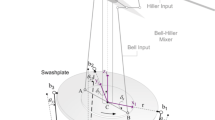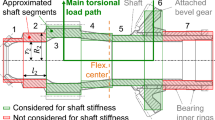Abstract
This work addresses the involuntary interaction between the pilot and the vehicle, with specific reference to helicopters along the vertical (or heave) axis. The problem is described and formulated mathematically. Means of analysis are discussed. Focus is placed on modeling requirements for both the vehicle and the pilot. Open problems and future work lines are sketched.
Similar content being viewed by others
References
J. C. Cockburn and B. G. Morton. Linear fractional representations of uncertain systems. Automatica, 33(7):1263–1271, July 1997. doi:10.1016/S0005-1098(97)00049-6.
O. Dieterich, J. G¨otz, B. DangVu, H. Haverdings, P. Masarati, M. D. Pavel, M. Jump, and M. Gennaretti. Adverse rotorcraft-pilot coupling: Recent research activities in Europe. In 34th European Rotorcraft Forum, Liverpool, UK, September 16–19 2008.
S. I. G. Bernardini, J. Serafini and M. Gennaretti. Assessment of computational models for the effect of aeroelasticity on BVI noise prediction. Int’l J. of Aeroacoustics, 6(3):199–222, 2007.
R. Gabel and G. J. Wilson. Test approaches to external sling load instabilities. Journal of the American Helicopter Society, 13(3):44–55, 1968. doi:10.4050/JAHS.13.44.
M. Gennaretti and G. Bernardini. Novel boundary integral formulation for blade-vortex interaction aerodynamics of helicopter rotors. AIAA Journal, 45(6):1169–1176, 2007. doi:10.2514/1.18383.
M. Gennaretti and G. Bernardini. Aeroacousto-elastic modeling for response analysis of helicopter rotors. In G. Buttazzo and A. Frediani, editors, Variational Analysis and Aerospace Engineering: Mathematical Challenges for Aerospace Design, pages 27–50. Springer Science+Business Media, LLC 2012, New York, 2012. doi:10.1007/978-1-4614-2435-2 2.
M. Gennaretti and D. Muro. Multiblade reduced-order aerodynamics for state-space aeroelastic modeling of rotors. Journal of Aircraft, 49(2):495–502, 2012. doi:10.2514/1.C031422.
M. Gennaretti, J. Serafini, P. Masarati, and G. Quaranta. Effects of biodynamic feedthrough in rotorcraft-pilot coupling: Collective bounce case. J. of Guidance, Control, and Dynamics, 36(6):1709–1721, 2013. doi:10.2514/1.61355.
M. Jump, S. Hodge, B. DangVu, P. Masarati, G. Quaranta, M. Mattaboni, M. D. Pavel, and O. Dieterich. Adverse rotorcraft-pilot coupling: Test campaign development at the university of Liverpool. In 34th European Rotorcraft Forum, Liverpool, UK, September 16–19 2008.
P. Masarati, G. Bindolino, and G. Quaranta. A parametric pilot/control device model for rotor-craft biodynamic feedthrough analysis. In 40th European Rotorcraft Forum, Southampton, UK, September 2–5 2014.
P. Masarati, M. Morandini, and P. Mantegazza. An efficient formulation for general-purpose multi-body/multiphysics analysis. J. of Computational and Nonlinear Dynamics, 9(4):041001, 2014. doi:10.1115/1.4025628.
P. Masarati and G. Quaranta. Bioaeroservoelastic analysis of involuntary rotorcraft-pilot interaction. J. of Computational and Nonlinear Dynamics, 9(3):031009, July 2014. doi:10.1115/1.4025354.
P. Masarati, G. Quaranta, and M. Jump. Experimental and numerical helicopter pilot characterization for aeroelastic rotorcraft-pilot couplings analysis. Proc. IMechE, Part G: J. Aerospace Engineering, 227(1):124–140, January 2013. doi:10.1177/0954410011427662.
P. Masarati, G. Quaranta, J. Serafini, and M. Gennaretti. Numerical investigation of aeroser-voelastic rotorcraft-pilot coupling. In XIX Congresso Nazionale AIDAA, Forlì, Italy, September 17–21 2007.
P. Masarati, G. Quaranta, and A. Zanoni. Dependence of helicopter pilots’ biodynamic feedthrough on upper limbs’ muscular activation patterns. Proc. IMechE Part K: J. Multi-body Dynamics, 227(4):344–362, December 2013. doi:10.1177/1464419313490680.
P. Masarati, G. Quaranta, and A. Zanoni. A detailed biomechanical pilot model for multi-axis involuntary rotorcraft-pilot couplings. In 41st European Rotorcraft Forum, Munich, Germany, September 1–4 2015.
J. R. Mayo. The involuntary participation of a human pilot in a helicopter collective control loop. In 15th European Rotorcraft Forum, pages 81.1–1.12, Amsterdam, The Netherlands, 12–15 September 1989.
V. Muscarello, P. Masarati, and G. Quaranta. Robust aeroservoelastic analysis for the investigation of rotorcraft pilot couplings. In 3rd CEAS Air & Space Conference, Venice, Italy, October 24–28 2011.
V. Muscarello, P. Masarati, and G. Quaranta. Robust aeroservoelastic analysis for the investigation of rotorcraft pilot couplings. l’Aerotecnica Missili e Spazio, 91(1–2):32–41, March–June 2012.
V. Muscarello, G. Quaranta, and P. Masarati. The role of rotor coning in helicopter prone-ness to collective bounce. Aerospace Science and Technology, 36:103–113, July 2014. doi:10.1016/j.ast.2014.04.006.
C. J. Ockier. Pilot induced oscillations in helicopters — three case studies. Technical Report IB 111-96/12, German Aerospace Center (DLR), Braunschweig, Germany, 1996.
M. D. Pavel, M. Jump, B. Dang-Vu, P. Masarati, M. Gennaretti, A. Ionita, L. Zaichik, H. Smaili, G. Quaranta, D. Yilmaz, M. Jones, J. Serafini, and J. Malecki. Adverse rotorcraft pilot couplings — past, present and future challenges. Progress in Aerospace Sciences, 62:1–51, October 2013. doi:10.1016/j.paerosci.2013.04.003.
M. D. Pavel, J. Malecki, B. DangVu, P. Masarati, G. Quaranta, M. Gennaretti, M. Jump, H. Smaili, A. Ionita, and L. Zaicek. Aircraft and rotorcraft pilot coupling: a survey of recent research activities within the European project ARISTOTEL. In 3rd CEAS Air & Space Conference, Venice, Italy, October 24–28 2011.
M. D. Pavel, P. Masarati, M. Gennaretti, M. Jump, L. Zaichik, B. Dang-Vu, L. Lu, D. Yilmaz, G. Quaranta, A. Ionita, and J. Serafini. Practices to identify and preclude adverse aircraft-and-rotorcraft-pilot couplings — a design perspective. Progress in Aerospace Sciences, 76:55–89, 2015. doi:10.1016/j.paerosci.2015.05.002.
M. D. Pavel, D. Yilmaz, O. Stroosma, B. Dang-Vu, P. Masarati, G. Quaranta, M. Gennaretti, M. Jump, L. Lu, M. Jones, H. Smaili, and L. Zaichik. Practices for identifying and precluding adverse aircraft- and rotorcraft-pilot couplings events — simulator guidelines. Progress in Aerospace Sciences, 77:54–87, August 2015. doi:10.1016/j.paerosci.2015.05.007.
G. Quaranta, V. Muscarello, and P. Masarati. Lead-lag damper robustness analysis for helicopter ground resonance. J. of Guidance, Control, and Dynamics, 36(4):1150–1161, July 2013. doi:10.2514/1.57188.
G. Quaranta, A. Tamer, V. Muscarello, P. Masarati, M. Gennaretti, J. Serafini, and M. M. Colella. Evaluation of rotorcraft aeroelastic stability using robust analysis. In 38th European Rotorcraft Forum, Amsterdam, NL, 2012.
G. Quaranta, A. Tamer, V. Muscarello, P. Masarati, M. Gennaretti, J. Serafini, and M. M. Colella. Rotorcraft aeroelastic stability using robust analysis. CEAS Aeronaut. J., 5(1):29–39, March 2014. doi:10.1007/s13272-013-0082-z.
S. Skogestad and I. Postlethwaite. Multivariable Feedback Control. John Wiley & Sons, Chichester, 2005.
M. D. Takahashi. H∞ helicopter flight control law design with and without rotor state feedback. J. of Guidance, Control, and Dynamics, 17(6):1245–1251, 1994. doi:10.2514/3.21340.
J. Venrooij, M. van Paassen, M. Mulder, D. Abbink, M. Mulder, F. van der Helm, and H. Bulthoff. A framework for biodynamic feedthrough analy sis part i: Theoretical foundations. Cybernetics, IEEE Transactions on, 44(9):1686–1698, September 2014. doi:10.1109/TCYB.2014.2311043.
S. Zanlucchi, P. Masarati, and G. Quaranta. A pilot-control device model for helicopter sensitivity to collective bounce. In ASME IDETC/CIE 2014, Buffalo, NY, August 17–20 2014. DETC2014-34479.
Author information
Authors and Affiliations
Rights and permissions
About this article
Cite this article
Quaranta, G., Masarati, P., Serafini, J. et al. Aeroelastic Rotorcraft-Pilot Couplings: Problems and Methods. Aerotec. Missili Spaz. 95, 176–187 (2016). https://doi.org/10.1007/BF03404726
Published:
Issue Date:
DOI: https://doi.org/10.1007/BF03404726




